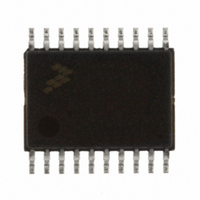MC9S08EL16CTJ Freescale Semiconductor, MC9S08EL16CTJ Datasheet - Page 265

MC9S08EL16CTJ
Manufacturer Part Number
MC9S08EL16CTJ
Description
MCU 16KB FLASH SLIC 20TSSOP
Manufacturer
Freescale Semiconductor
Series
HCS08r
Datasheet
1.DEMO9S08EL32.pdf
(356 pages)
Specifications of MC9S08EL16CTJ
Core Processor
HCS08
Core Size
8-Bit
Speed
40MHz
Connectivity
I²C, LIN, SCI, SPI
Peripherals
LVD, POR, PWM, WDT
Number Of I /o
16
Program Memory Size
16KB (16K x 8)
Program Memory Type
FLASH
Eeprom Size
512 x 8
Ram Size
1K x 8
Voltage - Supply (vcc/vdd)
2.7 V ~ 5.5 V
Data Converters
A/D 12x10b
Oscillator Type
External
Operating Temperature
-40°C ~ 85°C
Package / Case
20-TSSOP
Processor Series
S08EL
Core
HCS08
Data Bus Width
8 bit
Data Ram Size
1 KB
Interface Type
SCI, SPI, I2C, SLIC
Maximum Clock Frequency
200 KHz
Number Of Programmable I/os
16
Number Of Timers
2
Operating Supply Voltage
5.5 V
Maximum Operating Temperature
+ 85 C
Mounting Style
SMD/SMT
3rd Party Development Tools
EWS08
Development Tools By Supplier
DEMO9S08EL32AUTO, DEMO9S08EL32
Minimum Operating Temperature
- 40 C
On-chip Adc
10 bit, 12 Channel
For Use With
DEMO9S08EL32 - BOARD DEMO FOR 9S08 EL MCUDEMO9S08EL32AUTO - DEMO BOARD EL32 AUTO
Lead Free Status / RoHS Status
Lead free / RoHS Compliant
- Current page: 265 of 356
- Download datasheet (9Mb)
14.3.5.2
During all stop modes, clocks to the SCI module are halted.
In stop1 and stop2 modes, all SCI register data is lost and must be re-initialized upon recovery from these
two stop modes. No SCI module registers are affected in stop3 mode.
The receive input active edge detect circuit is still active in stop3 mode, but not in stop2. . An active edge
on the receive input brings the CPU out of stop3 mode if the interrupt is not masked (RXEDGIE = 1).
Note, because the clocks are halted, the SCI module will resume operation upon exit from stop (only in
stop3 mode). Software should ensure stop mode is not entered while there is a character being transmitted
out of or received into the SCI module.
14.3.5.3
When LOOPS = 1, the RSRC bit in the same register chooses between loop mode (RSRC = 0) or
single-wire mode (RSRC = 1). Loop mode is sometimes used to check software, independent of
connections in the external system, to help isolate system problems. In this mode, the transmitter output is
internally connected to the receiver input and the RxD pin is not used by the SCI, so it reverts to a
general-purpose port I/O pin.
14.3.5.4
When LOOPS = 1, the RSRC bit in the same register chooses between loop mode (RSRC = 0) or
single-wire mode (RSRC = 1). Single-wire mode is used to implement a half-duplex serial connection.
The receiver is internally connected to the transmitter output and to the TxD pin. The RxD pin is not used
and reverts to a general-purpose port I/O pin.
In single-wire mode, the TXDIR bit in SCIxC3 controls the direction of serial data on the TxD pin. When
TXDIR = 0, the TxD pin is an input to the SCI receiver and the transmitter is temporarily disconnected
from the TxD pin so an external device can send serial data to the receiver. When TXDIR = 1, the TxD pin
is an output driven by the transmitter. In single-wire mode, the internal loop back connection from the
transmitter to the receiver causes the receiver to receive characters that are sent out by the transmitter.
Freescale Semiconductor
Stop Mode Operation
Loop Mode
Single-Wire Operation
MC9S08EL32 Series and MC9S08SL16 Series Data Sheet, Rev. 3
Serial Communications Interface (S08SCIV4)
267
Related parts for MC9S08EL16CTJ
Image
Part Number
Description
Manufacturer
Datasheet
Request
R
Part Number:
Description:
Manufacturer:
Freescale Semiconductor, Inc
Datasheet:
Part Number:
Description:
Manufacturer:
Freescale Semiconductor, Inc
Datasheet:
Part Number:
Description:
Manufacturer:
Freescale Semiconductor, Inc
Datasheet:
Part Number:
Description:
Manufacturer:
Freescale Semiconductor, Inc
Datasheet:
Part Number:
Description:
Manufacturer:
Freescale Semiconductor, Inc
Datasheet:
Part Number:
Description:
Manufacturer:
Freescale Semiconductor, Inc
Datasheet:
Part Number:
Description:
Manufacturer:
Freescale Semiconductor, Inc
Datasheet:
Part Number:
Description:
Manufacturer:
Freescale Semiconductor, Inc
Datasheet:
Part Number:
Description:
Manufacturer:
Freescale Semiconductor, Inc
Datasheet:
Part Number:
Description:
Manufacturer:
Freescale Semiconductor, Inc
Datasheet:
Part Number:
Description:
Manufacturer:
Freescale Semiconductor, Inc
Datasheet:
Part Number:
Description:
Manufacturer:
Freescale Semiconductor, Inc
Datasheet:
Part Number:
Description:
Manufacturer:
Freescale Semiconductor, Inc
Datasheet:
Part Number:
Description:
Manufacturer:
Freescale Semiconductor, Inc
Datasheet:
Part Number:
Description:
Manufacturer:
Freescale Semiconductor, Inc
Datasheet:










